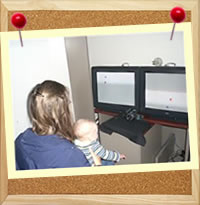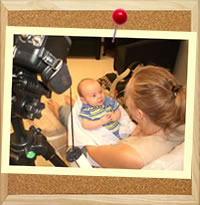Many parents worry about whether their babies are developing normally. Sometimes concerns about autism are unfounded, and sometimes they prove prescient, but either way parents have had to wait years before they can get a reliable diagnosis. That wait may soon be cut in half through the work of Dr. Mel Rutherford on the Early Autism Study at McMaster University.
The Early Autism Study is an ongoing attempt to hone early autism detection techniques. Infants are brought into the lab four times a year, at 3, 6, 9, and 12 months old, for short eye-movement evaluations. From the lap of a parent, these infants watch moving dots and then static photos of faces. The first of these evaluations takes only five minutes, and the second no more than ten, but by examining these brief clips researchers have been able to predict later autism diagnoses. By nine months, their software is able to reliably detect a lack of attention towards the cues that most infants instinctively focus on.
These eye-movement evaluations represent a significant advancement because prior tests could not make predictions before two years of age, and because the results can be evaluated objectively rather than relying upon subjective interviews. An example of the limitations of subjective judgments can be found in prior work by Dr. Rutherford on a diary of the mother of an autistic child. This mother recorded daily observations of her children’s speech development, sleep patterns, social interactions, and many other details. The mother did sense that something was different about one of her children, but despite her meticulous records she did not suspect autism until a psychologist diagnosed the child at the age of three.
The Early Autism Study is still looking for volunteers, and we can hope that it will continue to refine its early detection techniques. If caught earlier in development, autistic children can be more easily guided towards healthier social behavior. Abnormal eye movement is only one of the many symptoms associated with the autistic spectrum, and it might be caused by entirely different problems, but eye movement allows a much more objective measurement than other autism symptoms like lack of imaginitive play or emotional reciprocity. Parents will not get a definite diagnosis by taking their children to the Early Autism Study laboratory, but they will get an early warning that their child is developing far differently than average and requires special attention.

